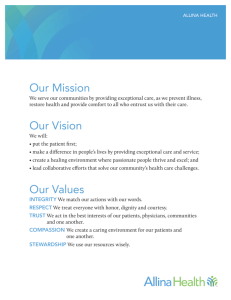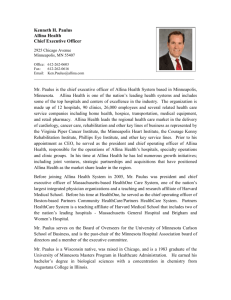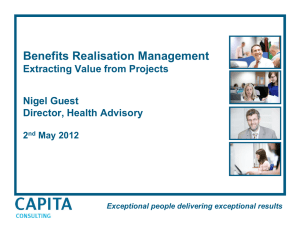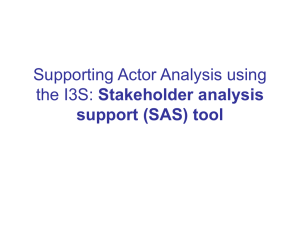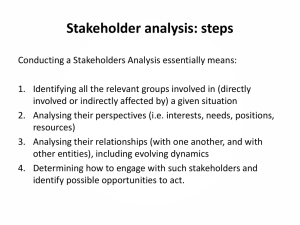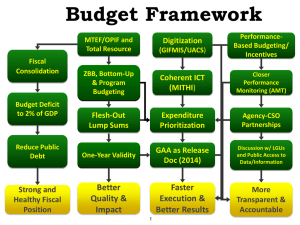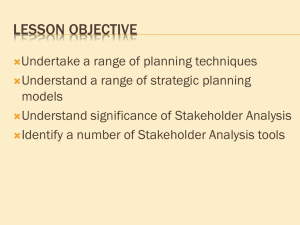slides
advertisement
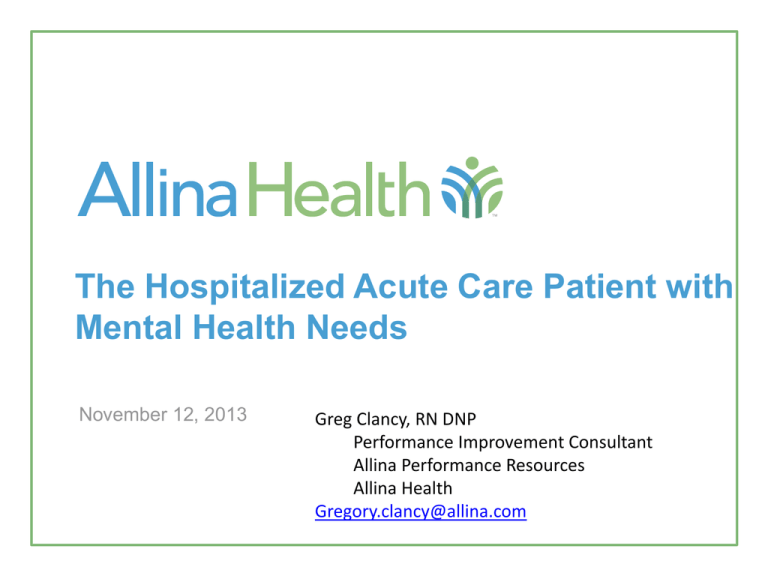
The Hospitalized Acute Care Patient with Mental Health Needs November 12, 2013 Greg Clancy, RN DNP Performance Improvement Consultant Allina Performance Resources Allina Health Gregory.clancy@allina.com Learning Objectives • Discuss how does mental health disorders and impact patients and patient care services • Describe how a performance improvement (PI) model can promotes healthcare system change Describe the challenges faced by a PI project to implement Mental Health services for patients on a busy surgical unit • Discuss integrated model of care to address challenges of caring for those with physical and mental conditions 2 Case study • Patient admitted to medical unit for HF with Depression 3 Terminology Mental Health illness or disorders Behavioral illness or disorders Co morbid conditions: medical and mental conditions Co-occurring disorders: When I use a word” Humpty Dumpty said rather scornful tone, “it means exactly What I want it to mean –neither more or less 4 Patients with Acute Illness and Co-morbid Mental Disorders • Unlike many medical disorders patients admitted with a mental health issue cannot be identified by a lab test. 5 Defining Mental Illness 6 Percent of US adults with Diagnostic Behavior Health Criteria 7 Medical Conditions Impact by Co-Morbid Mental Illness • Migraine headaches, chronic bronchitis, and back pain • About one fifth of patients hospitalized for a heart attack suffer from major depression • •Depressed patients also are three times more likely than non-depressed patients to be noncompliant with treatment recommendations 8 Impact of Mental Health Disorders is Prevalent and Substantial 9 Readmission of hospitalized patients with Mental Health Disorder • 37 percent of patients with mental illness discharged from acute care hospitals were readmitted within a period of one year, compared with only 27 percent of patients discharged without a mental illness. (Madi, et al., 2007). • Heart attack patients who were depressed were more likely to be readmitted in the year after discharge (Frasure-Smith, et al, 200) • Patients with severe anxiety had a threefold risk of cardiac related readmission, compared to those without anxiety (Volz, 2010) 10 Mortality • Individuals with serious mental illness die, on average, 25 years earlier than the general population 11 American health care “gets it right” 54.9% of the time. Performance Improvement is “getting it right” Allina Health performance resources is dedicated to improving care for patients and achieving better health and affordability for our communities. McGlynn EA, Asch SM, Adams J, et al. The quality of health care delivered to adults in the United States. N Engl J Med 2003; 348(26):2635-45 (June 26). 12 Allina’s Health Improvement Model “Establishing a Common Language of Improvement is a Key Success Factor.” 1. Institute of Medicine 2. Institute for Healthcare Improvement 3. The Joint Commission 13 Allina Health Improvement Model 10-Step Model 1. Allina Advanced Training Program (AATP) Pedigree 2. Intuitive Problem Solving Process 3. Mutes the debate between: Lean / Six-Sigma / Baldrige 4. Incorporates Key Tools 5. Building Consensus Across Allina 14 When to Use the 10 Steps • Solution unknown or discrepancy between stakeholders about suspected solution • When there is little understanding of current process, data, or customer requirements • When new process / disruption to current process is required 15 Tools are Tools Tools Can Help: • Measure, assess, diagnose, understand • Communicate • Prioritize, make decisions 16 Allina Health Improvement Model Ten Step Quality Improvement Process 1. What do we want to accomplish? 2. Who are the stakeholders? 3. How are we doing it now? Establish charter & aim statement Stakeholder identification and assessment Current state description 4. How do we want to do it in the future? 5. What keeps us from getting there? Future or desired state description Gap analysis Identify root causes and barriers 6. What changes can we make to get to the future state? 7. Do it. 8. How did we do? Test changes Monitor results, redesign tests 10. What did we learn? Capture lessons learned 17 Develop opportunities & Hypotheses 9. If it worked, can we do it every time? Standardize spread X Gantt chart X Plan-do-study-act cycle X X X X Project charter X X X X Stakeholder analysis X X Affinity diagram X X Benchmarking X Brainstorming X X Cause-and-effect matrix X X X X X X X X X X X X X X X X X X X X X X X X X X X X X X X X X X X X X Correlation analysis X X X Histogram X X X X X X X Run chart / Control Chart Survey 18 Fishbone diagram X X The Quality Toolbox; Second Edition, Nancy R. Tague, 2005. X X X X X X X X X X X X Work flow diagram Pareto chart 10 Learnings & Handoff X 6 Changes 9 Standardize & Spread Flowchart 8 Monitor X 7 Do It Checklist 5 Root Causes 4 Opportunitie s 3 Current State 2 Stake-holder Needs Tool 1 Charter & Plans Tool Matrix X X X X X X X X X X X X X X X X X X X X 1. What do we want to accomplish? Step 1 Charter and Aim Statement Establish charter & aim statement • • • • • Charter is a “contract” Clarifies expectations with sponsors Commits resources Aligned team members Identifies project scope - (What’s in and what’s out) Improving Transitions from Medical/Surgical Units for Patients with Mental Health Diagnoses Allina Health Advanced Training Program Cohort 5 July 12, 2013 Literature Review • Existing guidelines at Allina Health http://akn.allina.com/patientcare/ • External literature: Evidence Based Practice - Allina Health Library Services will help answer questions, gain knowledge, make more informed decisions 21 SMART Aim Statements Specific: • Defined population • Outcome metric is clear (not dollars) • Baseline is measured Measurable: • Statement articulates improvement from numerical baseline to numerical goal • Validated measurement system in place • Measureable verb, usually starts with “Increase” or “Decrease” Actionable • Empowers team to create change Realistic & Relevant • Aligned with strategic goal • Achievable within deadline • Consider a stretch goal (70% chance to get there) Timely • Has a firm due date Example: Increase the percent of patients receiving biopsies the same day as their diagnostic workup from a 2010 Allinawide baseline of 44% to 61% by the end of 2011. Background / Problem Statement • What is the problem? - Why is change needed? • a large number of patients discharging from a Medical/Surgical unit with a Mental Health diagnosis do not currently receive optimal care coordination related to their mental health needs. - How do you really know this is a problem? • Our internal risk tools, Emergency Department return rate, and readmission data identify this as a problem. • What will this project work attempt to solve? - Identify what services are necessary to assure that patients have transition plans that predict success for those patients with Mental Illnesses discharging from Medical/Surgical units. • Evidence of success would include: • Social work involvement during hospitalization • Mental health follow up arranged within 14 days of discharge from a Medical/Surgical unit. • Decreased readmission rates and Emergency Department return rate within 30 days What We Are Trying to Accomplish Aim Statement The aim of the project is to improve transitions of care for patients with mental health comorbidities on stations 2600 and 4500 at United Hospital upon discharge. This will be accomplished by identifying patients with a comorbid medical and mental health diagnosis of depression or anxiety, increasing social service engagement, and ensuring mental health follow up appointments scheduled within 14 days. This will be measured by a comparison of total percentage of patients returned to the Emergency Department within 30 days of discharge. 2. Who are the stakeholders? Stakeholder identification and assessment WHO cares and WHAT do they care about? • Identify customers, suppliers, doers, influencers, disruptors, champions • Understand their power, influence, requirements and level of support • Your team may have the best solution, but it will FAIL without proper stakeholder buy-in 25 Who Cares & What They Care About A Stakeholder Analysis (Part I) Stakeholder Stake in Project Potential impact on Project What is needed from the Stakeholder? Power / Interest Interest: High Open to Social Work intervention Open to appointments/ follow-up being set up Cooperation in identifying Providers Power: High Referral to Social Work as needed Power: High Patients Staff Nurses Physicians/N P/PA Nursing Leadership Open to intervention Help to identify patient with needs Interest: High Awareness of process – open to MH issues being addressed during medical hospitalization Power: High Identify appropriate diagnosis on active problem list Interest: Low Awareness in MH needs Agreement with process Interest: High Stakeholder Management Strategy [See Fig I] •Better outcomes •Patient education •Possible Insurance and logistical costs •Family/support system education •Social work to take lead •More complete discharge planning for their patients •Perception of increased workload •Education around process – follow up data to keep invested Assist with engaging patients in process Acknowledgement of •Possible impact on process. Encouragement •Education of process workload related to active of patients to participate problem list/patient Attention to Active •Follow up data to identification Problem list keep invested Power: High Awareness of process Perceived attitudes and/or risks of the Stakeholder? •Better outcomes for patients •Education on process •Follow up data to keep invested Who Cares & What They Care About A Stakeholder Analysis (Part II) Stakeholder Stake in Project What is needed from the Stakeholder? Perceived attitudes and/or risks of the Stakeholder? Stakeholder Management Strategy [See Fig I] Power: High Commitment to the process. •Better outcome for patients, more complete discharge plans •Education around comorbidities Interest: High Identify patients Increased workload Knowledge of resources Training/education related to MH needs Collection of data Training/education of resources available for MH Follow up data to keep invested Commitment to the process Referral to Social Work as needed. Better outcome for patients Education of process Potential impact on Project Power / Interest Social Workers Clinical Case Managers (RN) Outpatient Providers Identifying patients, meeting with them, arranging follow-up Power: Low Awareness of process Interest: Low Follow-up appointments scheduled Power: Low Availability of appointments Interest: High United Psychiatrist Power: Low Awareness of project Interest: High Will have better outcomes for their patients. Training/education related to MH needs Training/education of resources available for MH Nothing at this point Possible increased volume Participation in consults as needed Better patient outcomes Perception of increased workload Education on process Baseline Data Description • UTD 4500 (General Medicine), UTD 2600 (Surgery) are the test units. These units were selected due to their high volume of discharges and total rate of patients with mental health comorbidities. • Mental Health comorbidities are defined as patients who have Major Depressive Disorder, Depressive Disorder Not Otherwise Specified or Anxiety Disorder and a medical diagnosis. ICD9 Diagnosis Codes (296.xx, 300.xx,311) • We looked for the following information in a chart review to determine need and outcomes: 28 a social work consult during hospitalization a mental health plan post discharge a scheduled outpatient psychiatry appointment post discharge rate of patients returning to the Emergency Department within 30 days potentially preventable readmission rate within 30 days Baseline Data Description • Social Work Consult – Was there a social work consult during the visit? • Mental Health Plan – Was there either a preexisting appointment or was one set up during the stay? • Outpatient Psych – Did the patient have an established mental health provider stay? • Even though 4500 does a better job with these metrics….. Baseline Data Description • The ED return rate is much higher among depression patients vs. non-depression ones. • 4500 has a higher ED return rate among both depression and non-depression patients. 2012 ED Visit Rate by Discharge Department 35% ED Return Rate 30% 25% 29.1% 25.3% Better 22.3% 21.0% 20% 14.3% 17.0% 15% 10% 17.3% 13.7% 11.5% 5% 2600 / 4500 30 Day ED Visit Rate • 30 2600 30 Day ED Visit Rate with Depression Rate 4500 30 Day ED Visit Rate w/o Depression Rate ED return is counted as a visit to any Allina ED for any reason within 30 days of discharge. Pre-Intervention Workflow 5. What keeps us from getting there? Identify root causes and barriers What keeps us from getting there? • Explore the causes • Leverage data analysis to determine “root causes” and level of importance • Barriers and opportunities • PI Tools: - Fishbone or Cause-and-Effect Matrix - Workflow analysis tools 32 4. How do we want to do it in the future? Future or desired state description Gap analysis What can we do better? • Review issues that surfaced during steps 1-3 • Research: literature, industry • Document future state requirements / specifications (make sure you have sound measurement system) Positive Deviance Who is doing it better than you are and why is this? How can you emulate the behavior? Barriers To Mental Health Treatment A. Patient/ Family A.1. Stigma / Not Reporting A.2. Finances / Transportation B. Community Resources B.1. Lack of available resources B.2. Transportation A.3. Level of engagement A.4. Complexity of healthcare B.3. Compatible Appointment Times (evenings, weekends) C. Current Processes C.1. Mental Health Issues not identified C.2. Consult to Social Work not placed C.3. Time constraints C.4. Validity of active problem C.5. Short Hospitalizations Mental Health needs not D.1. Lack of education regarding E.1. Focus on their specialty sufficiently addressed Mental Health diagnoses E.2. Lack of awareness D.2. Lack of education regarding Mental Health F.1. Validity of Problem List regarding Mental Health treatment F.2. Challenges of Documentation resources D.3. Workload capacity for nursing / social work D. Staff 35 F.3. Lack of established data processes in Epic E. Physicians F. Data / Technology New Screening Process • MENTAL HEALTH SCREENING QUESTIONS (FOR NURSES): 1. Are you having any emotional or mental health problems at present? 2. Have you received any mental health treatment (medications, counseling/therapy) in the past? 3. Do you think you would benefit from receiving mental health services after discharge? 36 New Screening Process • MENTAL HEALTH SCREENING QUESTIONS (FOR NURSES): 1. Are you having any emotional or mental health problems at present? 2. Have you received any mental health treatment (medications, counseling/therapy) in the past? 3. Do you think you would benefit from receiving mental health services after discharge? 37 6. What changes can we make to get to the future state? Develop opportunities & Hypotheses What changes will we make • Select the best interventions • What do we need to implement to reach our goal? • Define the new process - What does it look like? - Who is going to do what? • Plan the transition - What does it take to implement? - How are we going to lead the change? 38 PI Tools: Prioritization Matrix Future State Map Checklist RACI Matrix PDSA Transition Plan Communication Plan Early Stages of Control Planning Project Plan Intervention Workflow 39 Project Timeline Improving Transitions for Med/Surg Patients with MH dx Develop Education/Training tools for RN staff Deanne Develop Education/Training tools for SW Diane/Deanne Implement Communication tools Diane/Sairam Provide Education/Training Collect/Analyze Data-SW engagement Collect/Analyze Data-Follow up appt RN leaders for 4500 & Develop education tool for RN's to 2600 know when to put in SW consult 4/29/13 5/13/13 Develop smartphrase to document SW for 4500 & 2600 decision making; Develop resource 4/29/13 list for follow up appointments 5/13/13 All Attend staff meetings, hospitalist meeting, huddles, etc. 5/13/13 6/3/13 All All Meet with RN staff to review SW consult process; Meet with SW staff to educate process for identifying 5/13/13 patients; implementing decision making, and arranging follow up 6/3/13 All SW for 4500 2600 Track data related to SW use of smartphrase 6/3/13 7/1/13 All SW for 4500 & 2600 Track data related to follow up appointments within 14 days 6/3/13 7/1/13 6/3/13 7/1/13 SW for 4500 & 2600; Communicate progress to all RN leaders for 4500 & stakeholders 2600 Communicate ongoing results All Analyze final data All all Analyze collected data for pilot project time period and determine effectiveness and success towards outcomes 7/1/13 7/11/13 Complete presentation All all Put project materials together for Session 4 presentations 7/1/13 7/11/13 Communicate final project results All all Communicate project effectiveness 7/15/13 and outcomes to all stakeholders Aug-13 All all Implement on other units and other sites as appropriate Ongoing Spread project to other 40units/sites Aug-13 7/29 7/22 7/8 7/15 5/13/13 7/1 Development of newsletter articles, memo's, and flyers to communicate 4/22/13 to staff about project Jul-13 6/24 all 6/17 All 6/3 4/29/13 6/10 Development of a decision tree for those patients who appear on the 4/15/13 report to determine if they are eligible for program. Jun-13 5/27 SW for 4500 & 2600 5/20 Sairam 5/6 Develop decision tree for SW staff We know that not all patients with active problems are appropriate. Who is? May-13 4/29 All 4/22 Sairam 4/15 4/29/13 Determine "eligible" patients 4/8 4/15/13 Participants Develop Communication tools Notes End Date Accountable 4/1 Project Step Apr-13 Start Date 5/13 Green Text = completed milestone Key Variables • Adaptive change takes considerable effort - Changing perspectives of front line providers Awareness of mental health issues Technical support with ongoing daily support Leadership support (informal and formal) • Timing of the service offering Fine tune the data mining process from the problem list Results Part I • UTD Station 4500 (medical) closed, we were only able to evaluate patients on unit 2600 (surgical) • 68 inpatient stays on 2600 resulted in consults to social work - Of those, 65 were from the problem list • 56 (82%) were seen by social work and 42 (62%) had a full assessment • Only 9 (13%) patients opted to have their mental health needs addressed. - Defined as having a future outpatient appointment with a psychiatrist or psychologist Results Part II • Why wasn’t the count higher? (n=68) • • • Predominantly a surgical unit Few referrals from Nursing staff Limited surgeon involvement • Why was opt-in rate so low? (13%) • Reliance on Problem List • Old problem carried forward • Many patients with mental health problems had already established treatment • Patient declined mental health intervention • Dementia was not included in this work What’s “Spread?” • The science of taking a local improvement (intervention, idea, process) and disseminating it across a system • There are many possible definitions for “a system” (e.g. a hospital, a group of hospitals, a region, a country) 44 Expansion of Project • A successful expansion would require: • A reliable screening method • Increased engagement of all providers • Technical resources available • Adding mental health screening questions to admission flowsheet • Feedback to providers to show benefits • Prioritization of patients seen for greater impact Creating a Culture of Improvement From To • Differing motivations • Collegial support and leveraging strengths of the whole • Differing approaches • Common language & approach to solving problems (Allina Health Improvement Model) • Reactive, intuitive work • Proactive use of analytics to predict and prevent issues • Clearly prioritized work, quantified benefit • Sustaining the gains, visibility of the performance • Effectively sharing and spreading the gains 46 Next steps for Integration 47 Resources & Links • Tague, N.R. (2005). Quality Toolbox (2005) ASQ Quality Press. Milwakee WI ISBN-10: 0873896394 • Institute for Healthcare Improvement (IHI): • Wikipedia Quality Tools: http://www.ihi.org/knowledge/Pages/default.aspx http://en.wikipedia.org/wiki/Six_Sigma#Quality_management_tools_and_methods_used_in_Six_Sigma • American Society for Quality: http://asq.org/knowledge-center/index.html (Tools tab) Bush, D.E., et al. (2005). Post-myocardial Infarction Depression. Evidence Report Technology Assessment. Number 123. Rockville, MD: Agency for Healthcare Research and Quality DiMatteo, M.R., Lepper, H.S., and Croghan, T.W. (2000). Depression Is a Risk Factorfor Noncompliance with Medical Treatment: Meta-analysis of the Effects of Anxiety and Depression on Patient Adherence. Archives of Internal Medicine, 160, 2101-2107. National Association of State Mental Health Program Directors. (October 2006). Morbidity and Mortality in People with Serious Mental Illness. Nasrallah, H.A., et al. (2006). Low Rates of Treatment for Hypertension, Dyslipidemia and Diabetes in Schizophrenia: Data from the CATIE Schizophrenia Trial Sample at Baseline. Schizophrenia Research, 86, 15-22 Patten, S. (March 2001). Long-term Medical Conditions and Major Depression in a Canadian Population Study at Waves 1 and 2. Journal of Affective Disorders, 63, 35-41. Questions?? Thank you • Greg Clancy, RN DNP Gregory.clancy@allina.com 49
